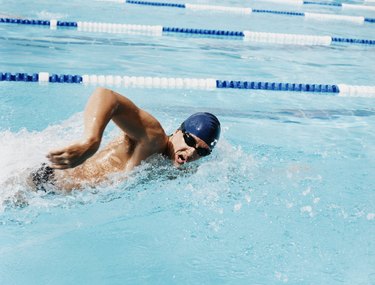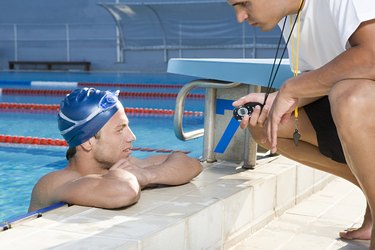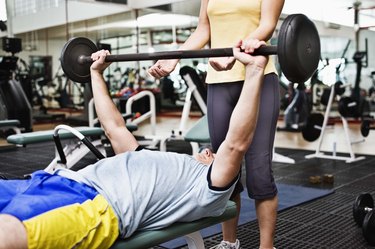
Olympic swimmers devote the majority of their time to swimming and living a healthy lifestyle. They must have discipline with their workouts as well as their diets. Swimmers train many hours in the pool but also train out of the water. Although each swim varies in distance and speed, swimmers work on building muscle and stamina to add the strength and speed needed to compete at such a high level.
Swimming
Video of the Day

Olympic swimmers have specific workout plans when they practice. They practice different strokes and techniques to boost their speed in a race. Coaches help swimmers study every aspect of their stroke. Swimmers work on mechanics of their strokes, diving into the pool, and push-offs from the wall at the end of each lap. The amount of time spent in the pool depends on the events the swimmer races. All swimmers swim several hours each day, but the training differs between sprinters and distance swimmers. Dara Torres, an Olympic sprinter, swims about two hours a day focusing on drills and specialized laps for about 5,000 meters. Janet Evans, a middle and distance swimmer, would swim up to 12 miles at some practices.
Video of the Day
Related Reading
Weight Training

Olympic swimmers are known for their broad and powerful shoulders. Building up strength in the upper body can help propel a swimmer through the water, which is essential to increasing speed. Michael Phelps uses dumbbells in his training to work his shoulders. Some exercises he performs are the dumbbell press, the dumbbell front raise, and the dumbbell lateral raise. These three exercises work the entire shoulder joint. Many swimmers lift weights to increase strength throughout the whole body. Dara Torres trains with weights four days a week for about 60 to 90 minutes a session. She works with a trainer using exercise balls and weights to work every muscle.
Stretching and Recovery
Working on flexibility is an essential part of a swimmer's exercise routine. Flexibility in the shoulder is needed in every stroke. Dara Torres calls stretching her "secret weapon." She incorporates yoga and massage as part of her flexibility training as well as regular sessions of assisted stretching with a trainer. Recovery is important as well. Swimmers receive massages on a regular basis. Massages help the muscles recover from strenuous workouts. Swimmers use ice baths too. An ice bath can reduce swelling and soreness, which are common in Olympic swimmers.
Nutrition

Proper nutrition is necessary for Olympic athletes. Swimmers burn lots of calories in their workouts, so they must consume enough calories to maintain their energy and meet their nutritional needs. Michael Phelps consumes 12,000 calories each day. Every swimmer must eat a balance between carbohydrates for energy and protein for muscle growth and development. Michael Phelps eats oatmeal or cereal before practice and eggs, omelets and vegetables after practice.